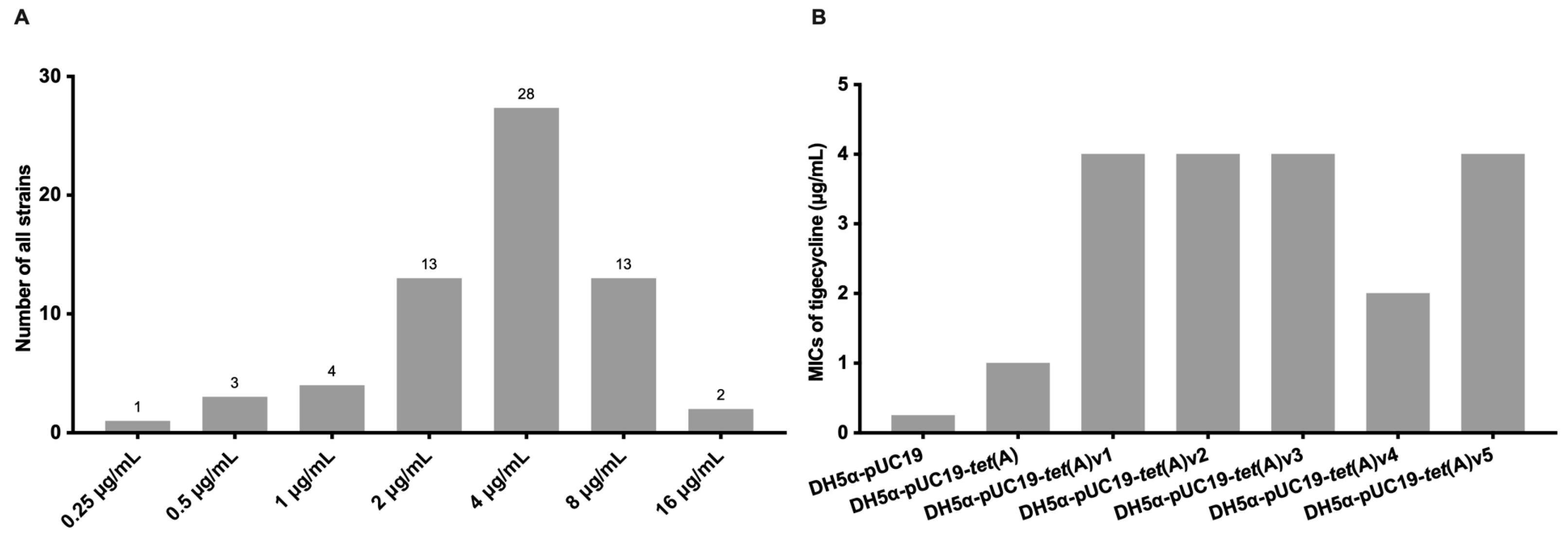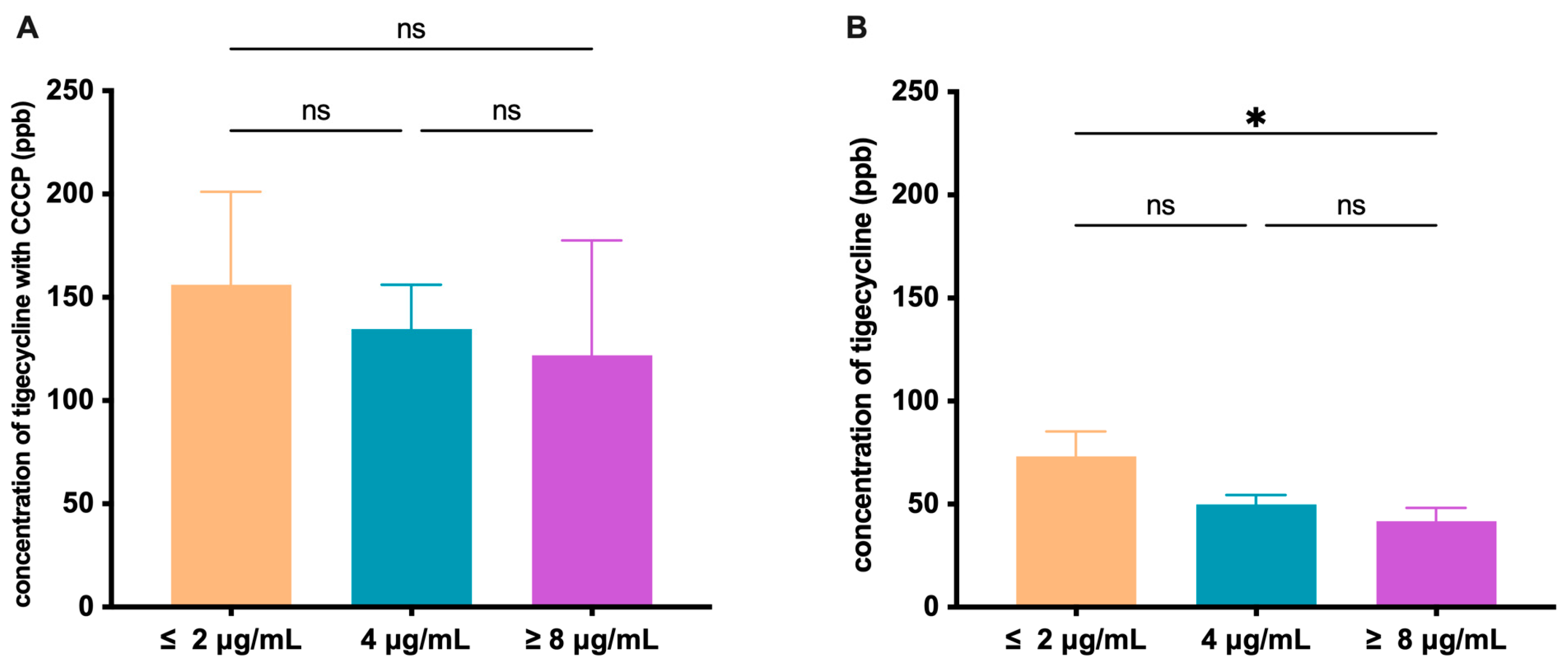Tigecycline Sensitivity Reduction in Escherichia coli Due to Widely Distributed tet(A) Variants
Abstract
:1. Introduction
2. Materials and Methods
2.1. Bacterial Strains
2.2. Antimicrobial Susceptibility Testing
2.3. Conjugation Assay
2.4. Functional Metagenomics
2.5. Cloning of tet(A) Variants
2.6. Whole-Genome Sequencing and Bioinformatics Analysis
2.7. RNA Extraction and RT-PCR Analysis
2.8. Accumulation of Tigecycline within E. coli Harboring tet(A) Variant
2.9. Statistical and Correlation Analyses
3. Results
3.1. Mutations of the tet(A) Gene Decrease Tigecycline Sensitivity in E. coli
3.2. Phenotype Variations Are Not Correlated with the Expression of tet(A) and tet(R)
3.3. tet(A) Variants Are Mostly Plasmid-Borne
3.4. tet(A) Variants Are Widely Distributed in E. coli from Human Clinical and Animals
4. Discussion
5. Conclusions
Supplementary Materials
Author Contributions
Funding
Data Availability Statement
Conflicts of Interest
References
- Daghrir, R.; Drogui, P. Tetracycline Antibiotics in the Environment: A Review. Environ. Chem. Lett. 2013, 11, 209–227. [Google Scholar] [CrossRef]
- Chopra, I.; Roberts, M. Tetracycline Antibiotics: Mode of Action, Applications, Molecular Biology, and Epidemiology of Bacterial Resistance. Microbiol. Mol. Biol. Rev. 2001, 65, 232–260. [Google Scholar] [CrossRef] [PubMed]
- Pormohammad, A.; Nasiri, M.J.; Azimi, T. Prevalence of Antibiotic Resistance in Escherichia coli Strains Simultaneously Isolated from Humans, Animals, Food, and the Environment: A Systematic Review and Meta-Analysis. Infect. Drug Resist. 2019, 12, 1181–1197. [Google Scholar] [CrossRef] [PubMed]
- Zhang, P.; Shen, Z.; Zhang, C.; Song, L.; Wang, B.; Shang, J.; Yue, X.; Qu, Z.; Li, X.; Wu, L.; et al. Surveillance of Antimicrobial Resistance among Escherichia coli from Chicken and Swine, China, 2008–2015. Vet. Microbiol. 2017, 203, 49–55. [Google Scholar] [CrossRef] [PubMed]
- Roberts. Mechanism of Resistance for Characterized Tet and Otr Genes, Last Modified 20 April 2021. 2021. Available online: https://faculty.washington.edu/marilynr/tetweb1.pdf (accessed on 23 August 2023).
- Roberts, M.C. Tetracycline Resistance Determinants: Mechanisms of Action, Regulation of Expression, Genetic Mobility, and Distribution. FEMS Microbiol. Rev. 1996, 19, 1–24. [Google Scholar] [CrossRef] [PubMed]
- Truong, D.T.Q.; Hounmanou, Y.M.G.; Dang, S.T.T.; Olsen, J.E.; Truong, G.T.H.; Tran, N.T.; Scheutz, F.; Dalsgaard, A. Genetic Comparison of ESBL-Producing Escherichia coli from Workers and Pigs at Vietnamese Pig Farms. Antibiotics 2021, 10, 1165. [Google Scholar] [CrossRef] [PubMed]
- Markley, J.L.; Fang, L.; Gasparrini, A.J.; Symister, C.T.; Kumar, H.; Tolia, N.H.; Dantas, G.; Wencewicz, T.A. Semisynthetic Analogues of Anhydrotetracycline as Inhibitors of Tetracycline Destructase Enzymes. ACS Infect. Dis. 2019, 5, 618–633. [Google Scholar] [CrossRef]
- Ferro, B.E.; Srivastava, S.; Deshpande, D.; Pasipanodya, J.G.; van Soolingen, D.; Mouton, J.W.; van Ingen, J.; Gumbo, T. Tigecycline Is Highly Efficacious against Mycobacterium Abscessus Pulmonary Disease. Antimicrob. Agents Chemother. 2016, 60, 2895–2900. [Google Scholar] [CrossRef]
- Hirata, T.; Saito, A.; Nishino, K.; Tamura, N.; Yamaguchi, A. Effects of Efflux Transporter Genes on Susceptibility of Escherichia coli to Tigecycline (GAR-936). Antimicrob. Agents Chemother. 2004, 48, 2179–2184. [Google Scholar] [CrossRef]
- He, T.; Wang, R.; Liu, D.; Walsh, T.R.; Zhang, R.; Lv, Y.; Ke, Y.; Ji, Q.; Wei, R.; Liu, Z.; et al. Emergence of Plasmid-Mediated High-Level Tigecycline Resistance Genes in Animals and Humans. Nat. Microbiol. 2019, 4, 1450–1456. [Google Scholar] [CrossRef]
- Sun, C.; Cui, M.; Zhang, S.; Wang, H.; Song, L.; Zhang, C.; Zhao, Q.; Liu, D.; Wang, Y.; Shen, J.; et al. Plasmid-Mediated Tigecycline-Resistant Gene tet(X4) in Escherichia coli from Food-Producing Animals, China, 2008–2018. Emerg. Microbes Infect. 2019, 8, 1524–1527. [Google Scholar] [CrossRef] [PubMed]
- Zhai, W.; Tian, Y.; Lu, M.; Zhang, M.; Song, H.; Fu, Y.; Ma, T.; Sun, C.; Bai, L.; Wang, Y.; et al. Presence of Mobile Tigecycline Resistance Gene tet(X4) in Clinical Klebsiella pneumoniae. Microbiol. Spectr. 2022, 10, e01081-21. [Google Scholar] [CrossRef] [PubMed]
- Lv, L.; Wan, M.; Wang, C.; Gao, X.; Yang, Q.; Partridge, S.R.; Wang, Y.; Zong, Z.; Doi, Y.; Shen, J.; et al. Emergence of a Plasmid-Encoded Resistance-Nodulation-Division Efflux Pump Conferring Resistance to Multiple Drugs, Including Tigecycline, in Klebsiella pneumoniae. mBio 2020, 11, e02930-19. [Google Scholar] [CrossRef] [PubMed]
- Ribera, A.; Roca, I.; Ruiz, J.; Gibert, I.; Vila, J. Partial Characterization of a Transposon Containing the tet(A) Determinant in a Clinical Isolate of Acinetobacter baumannii. J. Antimicrob. Chemother. 2003, 52, 477–480. [Google Scholar] [CrossRef] [PubMed]
- Stine, O.C.; Johnson, J.A.; Keefer-Norris, A.; Perry, K.L.; Tigno, J.; Qaiyumi, S.; Stine, M.S.; Morris, J.G. Widespread Distribution of Tetracycline Resistance Genes in a Confined Animal Feeding Facility. Int. J. Antimicrob. Agents 2007, 29, 348–352. [Google Scholar] [CrossRef] [PubMed]
- Chiu, S.-K.; Huang, L.-Y.; Chen, H.; Tsai, Y.-K.; Liou, C.-H.; Lin, J.-C.; Siu, L.K.; Chang, F.-Y.; Yeh, K.-M. Roles of ramR and tet(A) Mutations in Conferring Tigecycline Resistance in Carbapenem-Resistant Klebsiella pneumoniae Clinical Isolates. Antimicrob. Agents Chemother. 2017, 61, e00391-17. [Google Scholar] [CrossRef] [PubMed]
- Akiyama, T.; Presedo, J.; Khan, A.A. The tetA Gene Decreases Tigecycline Sensitivity of Salmonella enterica Isolates. Int. J. Antimicrob. Agents 2013, 42, 133–140. [Google Scholar] [CrossRef]
- Sun, C.; Cui, M.; Zhang, S.; Liu, D.; Fu, B.; Li, Z.; Bai, R.; Wang, Y.; Wang, H.; Song, L.; et al. Genomic Epidemiology of Animal-Derived Tigecycline-Resistant Escherichia coli across China Reveals Recent Endemic Plasmid-Encoded tet(X4) Gene. Commun. Biol. 2020, 3, 412. [Google Scholar] [CrossRef]
- CLSI. Performance Standards for Antimicrobial Susceptibility Testing. 2021. Available online: https://clsi.org/standards/products/microbiology/documents/m100/ (accessed on 21 September 2021).
- Nurk, S.; Bankevich, A.; Antipov, D.; Gurevich, A.A.; Korobeynikov, A.; Lapidus, A.; Prjibelski, A.D.; Pyshkin, A.; Sirotkin, A.; Sirotkin, Y.; et al. Assembling Single-Cell Genomes and Mini-Metagenomes From Chimeric MDA Products. J. Comput. Biol. 2013, 20, 714–737. [Google Scholar] [CrossRef]
- Wick, R.R.; Judd, L.M.; Gorrie, C.L.; Holt, K.E. Unicycler: Resolving Bacterial Genome Assemblies from Short and Long Sequencing Reads. PLoS Comput. Biol. 2017, 13, e1005595. [Google Scholar] [CrossRef]
- Carattoli, A.; Zankari, E.; García-Fernández, A.; Voldby Larsen, M.; Lund, O.; Villa, L.; Møller Aarestrup, F.; Hasman, H. In Silico Detection and Typing of Plasmids Using PlasmidFinder and Plasmid Multilocus Sequence Typing. Antimicrob. Agents Chemother. 2014, 58, 3895–3903. [Google Scholar] [CrossRef] [PubMed]
- Tong, Z.; Xu, T.; Deng, T.; Shi, J.; Wang, Z.; Liu, Y. Benzydamine Reverses TMexCD-TOprJ-Mediated High-Level Tigecycline Resistance in Gram-Negative Bacteria. Pharmaceuticals 2021, 14, 907. [Google Scholar] [CrossRef] [PubMed]
- Yu, R.; Li, L.; Zou, C.; Chen, Z.; Schwarz, S.; Chen, S.; Xu, C.; Yao, H.; Du, X.-D. Emergence of High-Level Tigecycline Resistance Due to the Amplification of a tet(A) Gene Variant in Clinical Carbapenem-Resistant Klebsiella pneumoniae. Clin. Microbiol. Infect. 2023, 29, 1452.e1–1452.e7. [Google Scholar] [CrossRef] [PubMed]
- Yamaguchi, A.; Akasaka, T.; Kimura, T.; Sakai, T.; Adachi, Y.; Sawai, T. Role of the Conserved Quartets of Residues Located in the N- and C-Terminal Halves of the Transposon Tn10-Encoded Metal-Tetracycline/Hydrogen Ion Antiporter of Escherichia coli. Biochemistry 1993, 32, 5698–5704. [Google Scholar] [CrossRef] [PubMed]
- Tamura, N.; Konishi, S.; Yamaguchi, A. Mechanisms of Drug/H+ Antiport: Complete Cysteine-Scanning Mutagenesis and the Protein Engineering Approach. Curr. Opin. Chem. Biol. 2003, 7, 570–579. [Google Scholar] [CrossRef]
- Tuckman, M.; Petersen, P.J.; Projan, S.J. Mutations in the Interdomain Loop Region of the tetA (A) Tetracycline Resistance Gene Increase Efflux of Minocycline and Glycylcyclines. Microb. Drug Resist. 2000, 6, 277–282. [Google Scholar] [CrossRef]
- Hentschke, M.; Christner, M.; Sobottka, I.; Aepfelbacher, M.; Rohde, H. Combined ramR Mutation and Resence of a Tn1721-Associated tet(A) Variant in a Clinical Isolate of Salmonella enterica Serovar Hadar Resistant to Tigecycline. Antimicrob. Agents Chemother. 2010, 54, 1319–1322. [Google Scholar] [CrossRef]
- Fyfe, C.; Sutcliffe, J.A.; Grossman, T.H. Susceptibility of Tetracyclines to tet(A) Resistance Is Independent of Interdomain Loop Sequence. Antimicrob. Agents Chemother. 2013, 57, 2430–2431. [Google Scholar] [CrossRef]
- Zuttion, F.; Colom, A.; Matile, S.; Farago, D.; Pompeo, F.; Kokavecz, J.; Galinier, A.; Sturgis, J.; Casuso, I. High-Speed Atomic Force Microscopy Highlights New Molecular Mechanism of Daptomycin Action. Nat. Commun. 2020, 11, 6312. [Google Scholar] [CrossRef]
- Su, J.-Q.; Wei, B.; Ou-Yang, W.-Y.; Huang, F.-Y.; Zhao, Y.; Xu, H.-J.; Zhu, Y.-G. Antibiotic Resistome and Its Association with Bacterial Communities during Sewage Sludge Composting. Environ. Sci. Technol. 2015, 49, 7356–7363. [Google Scholar] [CrossRef]
- Viveiros, M.; Dupont, M.; Rodrigues, L.; Couto, I.; Davin-Regli, A.; Martins, M.; Pagès, J.-M.; Amaral, L. Antibiotic Stress, Genetic Response and Altered Permeability of E. coli. PLoS ONE 2007, 2, e365. [Google Scholar] [CrossRef] [PubMed]
- Chetri, S.; Singha, M.; Bhowmik, D.; Nath, K.; Chanda, D.D.; Chakravarty, A.; Bhattacharjee, A. Transcriptional response of OmpC and OmpF in Escherichia coli against differential gradient of carbapenem stress. BMC Res. Notes 2019, 12, 138. [Google Scholar] [CrossRef] [PubMed]
- Pourahmad Jaktaji, R.; Zargampoor, F. Expression of TolC and Organic Solvent Tolerance of Escherichia coli Ciprofloxacin Resistant Mutants. Iran J. Pharm Res. 2017, 16, 1185–1189. [Google Scholar] [PubMed]



| ID | MIC 1 (µg/mL) of | |||
|---|---|---|---|---|
| TGC | TET | DOX | OMC | |
| ATCC 25922 | 0.25 | 2 | 2 | 1 |
| DH5α-pUC19-Tet(A) | 1 | 20 | 80 | 4 |
| DH5α-pUC19-Tet(A)-I5R | 1 | 20 | 50 | 4 |
| DH5α-pUC19-Tet(A)-V55M | 2 | 40 | 120 | 8 |
| DH5α-pUC19-Tet(A)-I75V | 1 | 30 | 110 | 7 |
| DH5α-pUC19-Tet(A)-T84A | 1 | 30 | 100 | 5 |
| DH5α-pUC19-Tet(A)-ASF 2 | 1 | 50 | 120 | 8 |
Disclaimer/Publisher’s Note: The statements, opinions and data contained in all publications are solely those of the individual author(s) and contributor(s) and not of MDPI and/or the editor(s). MDPI and/or the editor(s) disclaim responsibility for any injury to people or property resulting from any ideas, methods, instructions or products referred to in the content. |
© 2023 by the authors. Licensee MDPI, Basel, Switzerland. This article is an open access article distributed under the terms and conditions of the Creative Commons Attribution (CC BY) license (https://creativecommons.org/licenses/by/4.0/).
Share and Cite
Zhang, S.; Cui, M.; Liu, D.; Fu, B.; Shi, T.; Wang, Y.; Sun, C.; Wu, C. Tigecycline Sensitivity Reduction in Escherichia coli Due to Widely Distributed tet(A) Variants. Microorganisms 2023, 11, 3000. https://doi.org/10.3390/microorganisms11123000
Zhang S, Cui M, Liu D, Fu B, Shi T, Wang Y, Sun C, Wu C. Tigecycline Sensitivity Reduction in Escherichia coli Due to Widely Distributed tet(A) Variants. Microorganisms. 2023; 11(12):3000. https://doi.org/10.3390/microorganisms11123000
Chicago/Turabian StyleZhang, Shan, Mingquan Cui, Dejun Liu, Bo Fu, Tingxuan Shi, Yang Wang, Chengtao Sun, and Congming Wu. 2023. "Tigecycline Sensitivity Reduction in Escherichia coli Due to Widely Distributed tet(A) Variants" Microorganisms 11, no. 12: 3000. https://doi.org/10.3390/microorganisms11123000




